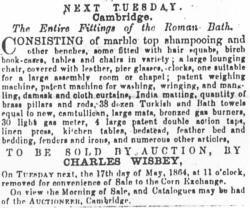4. Postlude
Finally, an advertisement, apparently placed by the company (since no official vendor is indicated), appeared in the columns of the Cambridge Chronicle giving notice that the contents of the building were to be auctioned three days later. 18
 Distressing though the sale must have been to the company, it has given us, 150 years after the event, a fascinating picture of what was required to furnish and run an establishment like this: we are reminded that even in the cooling-room, there would have been heat from the gas lights; we can tell from the shampooing slabs and from the omission of
strigils that the shampooing would have been Turkish style, albeit perhaps more gentle; that bathers then, as today, probably believed that they would lose weight in the Turkish bath; that the floor was probably too hot to walk on without wearing slippers, or pattens; that the bathers’ towels were washed and dried on the premises and—most telling of all—that there had been so few bathers that the towels were almost as good as new.
Distressing though the sale must have been to the company, it has given us, 150 years after the event, a fascinating picture of what was required to furnish and run an establishment like this: we are reminded that even in the cooling-room, there would have been heat from the gas lights; we can tell from the shampooing slabs and from the omission of
strigils that the shampooing would have been Turkish style, albeit perhaps more gentle; that bathers then, as today, probably believed that they would lose weight in the Turkish bath; that the floor was probably too hot to walk on without wearing slippers, or pattens; that the bathers’ towels were washed and dried on the premises and—most telling of all—that there had been so few bathers that the towels were almost as good as new.
By 2 July, a liquidator had been appointed and the mortgagee, a Mr Chappell, was in possession of the building which was now offered for sale. 15
Extensive Freehold Estate, The Roman Baths
By order of the Mortgagees with the concurrence of the
Liquidator under a Winding-Up Order
This very extensive PROPERTY, recently erected with Brick-and-
slate at a considerable cost, is situate in one of the
most preferable parts of the town; its superstructure
is very substantial and its inner arrangements are such
that it might easily be converted into Assembly and other Rooms,
although it is well adapted for the purpose for which it was
built; it has a handsome Portico Entrance with Stone Steps and
Iron Fence, giving it a very imposing appearance.
According to Walter Morley Fletcher, Chappell sold the property in October 1865 to Sir Matthew Digby Wyatt for £2,700, which suggests that this was in some way connected with the company’s non-payment of the architect’s fees.
On 6 September 1866, a letter from the Registrar of Companies demanding the company’s annual returns was sent back, marked ‘Company broken up’. 16
Not until 1874, when Walter Flack opened an establishment at 25 St Andrew’s Street, did Cambridge get a successful, if more modest, Turkish bath, which remained open until the turn of the century. 17